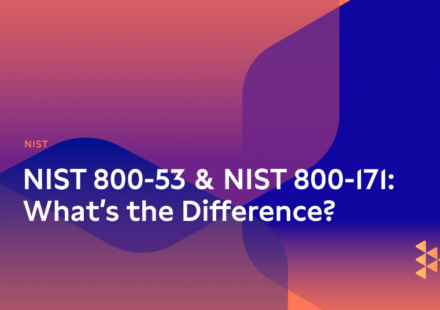NIST 800-53 and NIST 800-171 are both great cybersecurity framework options issued by the National Institute of Standards and Technology (NIST) that can bolster your security posture. Each of these frameworks outlines security and privacy best practices, categorizes these best practices into controls, and gives guidance on how to implement these controls in your security program.
In this blog post, we’ll explore the following:
- What NIST 800-53 is
- What NIST 800-171 is
- The differences between the NIST 800-53 and NIST 800-171 frameworks
- The similarities between the NIST 800-53 and NIST 800-171 frameworks
- Next steps for NIST 800-53 and NIST 800-171 compliance
Brief Overview: What is NIST 800-53?
NIST 800-53 is a publication by the National Institute of Standards and Technology (NIST) that provides comprehensive security controls for federal information systems. These controls are used by federal agencies to protect sensitive and classified information, as well as non-sensitive information critical to the federal government’s functioning.
NIST 800-53’s 1000+ security controls can be classified under these three types of control families:
- Management controls: These provide the policies and procedures for managing and overseeing the security of information systems.
- Operational controls: These focus on the day-to-day activities that ensure the security of information systems.
- Technical controls: These are the specific security measures that are implemented in information systems to protect against cyber threats.
What is NIST 800-171?
NIST 800-171 is a subset of NIST 800-53 that specifically addresses the security requirements for non-federal information systems that process, store, or transmit controlled unclassified information (CUI).
CUI is information that is not classified but still requires protection, such as financial information, intellectual property, and personal information.
NIST 800-171 contains 110 security requirements across 14 different control families. These requirements are designed to protect the confidentiality, integrity, and availability of CUI in information systems.
Both security frameworks provide specific requirements that must be implemented to ensure the security of information systems.
For example, both guidelines require the implementation of access control measures to ensure that only authorized individuals have access to sensitive information.
The Differences Between NIST 800-53 and NIST 800-171
While both NIST 800-53 and NIST 800-171 provide guidance on security controls for information systems, the two have several key differences.
Scope
NIST 800-53 provides a comprehensive set of security controls for federal information systems, while NIST 800-171 specifically addresses the security requirements for non-federal information systems that process, store, or transmit CUI. Another difference is the scope that each security framework uses when assessing information systems. NIST 800-53’s 1000+ security controls cover a wide range of control families, including access control, incident response, system and communication protection, and physical security. NIST 800-171’s goal is specifically to protect CUI from being disclosed to persons who do not have authorization.
Number of Controls
NIST 800-53 contains over 1000 security controls, while NIST 800-171 contains 110 security requirements. Despite this difference in scope, both guidelines provide similar controls that cover the full range of security requirements.
Audience
One of the main differences between NIST 800-53 and NIST 800-171 is their intended audience. NIST 800-53 was created specifically for organizations that operate in federal information ecosystems, while NIST 800-171 is meant for organizations that handle controlled unclassified information (CUI) for the federal government.
Implementation
NIST 800-53 is mandatory for federal agencies, while compliance with NIST 800-171 is voluntary for non-federal organizations. However, organizations that handle CUI on the federal government’s behalf must comply with NIST 800-171 under the Defense Federal Acquisition Regulation Supplement (DFARS).
Level of Detail
NIST 800-53 provides a more detailed set of security controls and guidance than NIST 800-171, which provides more high-level security requirements.
Impact on Cybersecurity
Compliance with NIST 800-53 and NIST 800-171 can help organizations improve their cybersecurity posture by providing a comprehensive set of security controls and requirements. Compliance with these guidelines can also help organizations demonstrate their commitment to cybersecurity to customers and stakeholders.
Compliance with NIST 800-53 is mandatory for organizations that handle federal information, and failure to comply can result in penalties and fines. For non-federal organizations, compliance with NIST 800-171 is voluntary but may be required by contracts with the federal government. Failure to comply with NIST 800-171 can result in the loss of government contracts or legal action.
The Similarities Between NIST 800-53 and NIST 800-171
One similarity between NIST 800-53 compliance and NIST 8000 171 compliance requirements is that they both are based on “establishing a security control baseline” for companies to leverage. This baseline gives organizations a clear jumping-off point on their path to compliance by providing guidance on their security policy development and procedures.
Both also use the risk management framework as a bedrock for determining a consistent and replicable process for assessing security risks and applying the appropriate security controls to mitigate said security risks.
NIST 800-53 and NIST 800-171 compliance also require that there be continuous monitoring in place to ensure that the security controls are implemented and maintained over time. Continuous monitoring includes having periodic assessments that validate the effectiveness of security controls, gap identification, and remediation actions that need to be taken to rectify them.
While NIST 800-53 and NIST 800-171 provide valuable guidance for protecting information, they are meant for different audiences, and their scope, level of detail, and implementation vary. If your business handles CUI for the federal government, refer to NIST 800-171 for compliance requirements, and those that operate or use federal information systems should refer to NIST 800-53 set of security controls.
The best approach is to leverage NIST 800-53 and NIST 800-171 together to create a robust and secure program that has a comprehensive set of recommendations for establishing a solid security foundation that complies with federal law.
Next Steps: How Carbide Helps Speed the NIST 800-53 and NIST 800-171 Compliance Process
Carbide sets you up for success by setting the goals and tasks you need to meet. Easily execute on our fool-proof plan with a platform that gives you a holistic view of your security posture. Focus on your business while we provide the scoping, automate your evidence-collection process (with our 100+ technical integrations) and get that automated security report in front of your stakeholders and decision-makers so you can grow securely.
Here are two ways to begin:
- Book a demo with our team to learn more.
- Share this blog post if you found it helpful via LinkedIn or Twitter.


